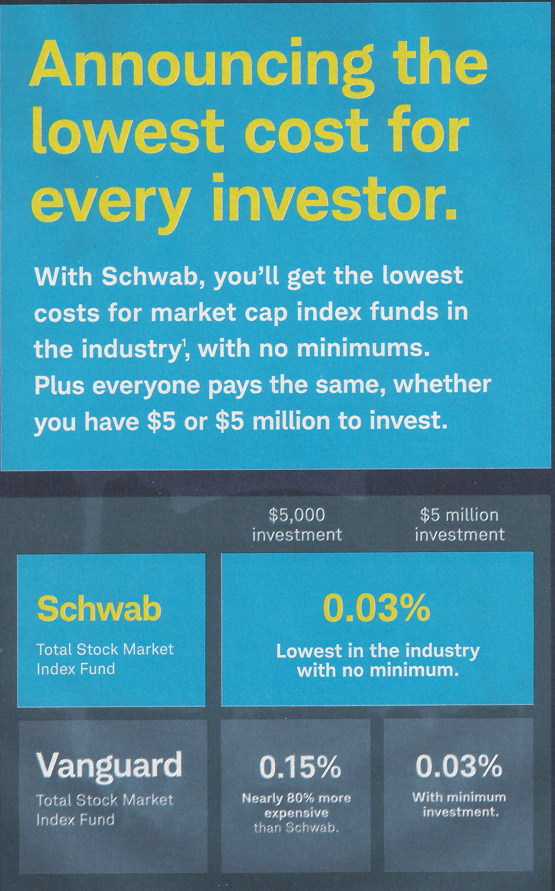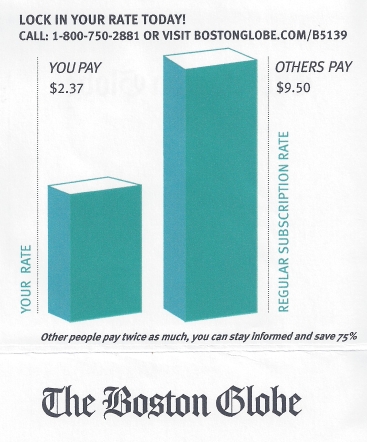If Vanguard charges .15% and Schwab, .03%, Vanguard’s fee is five time as much or 400% higher. They charge 12 basis points more. (A basis point is .01%, used in the financial industry). Schwab?



This is a snapshot of a Tweet in my feed. Painful to read for a few reasons, the grammar, of course, is the least of it.
Let’s start with US population. 327.2 million as of 2018. If we agree it’s close to 333 million, that’s 1/3 of a billion. In other words, $3 per person adds to $1B dollars. In which case, $460B isn’t quite $1400 per person. But, of course, even Jeff Bezos, the US richest person, is ‘only’ worth $114B. And Bloomberg might have spent $460M, not billion. Bloomberg is worth about $64 billion, and that divides to a number closer to $200 per person.
This, to me, is classic innumeracy, the inability to think about how absurd the tweet above was, before hitting “send”. As far as the grammar goes, I blame J. Geils for this one.
Ha! That’s today’s date. My daughter tells me this is not remarkable. That I seem to come up with an observation like this pretty often. Well, to be fair, I was pretty excited when it was 3/14/15 especially the two times the clock showed 9:26:53. But that was a year and a half ago.
Let’s see when my next date of interest will be. Stay tuned.
 The grapes were on sale, $1.99. But, with a $25 purchase and coupon from my store flyer, $0.97 per pound. When I went to buy the other items, the chicken I wanted was out of stock. I got a raincheck, and at the same time, asked the customer service person if they’d honor the grape sale even though my order was under $25. They agreed, but good luck trying to override anything on a cash register. The cashier couldn’t figure it out and the manager finally came over and couldn’t do it either. Finally, he said he’d just enter a credit. Now, $1.03/lb discount times 4.52 lbs might be tough to do in your head. $1 times 4.5 is $4.50. The extra .03/lb gets us to $4.63. I’d have been happy with $4.50, I just wanted to leave. $5.56 is what he entered as a discount. Final cost $3.43 for 4.52 lbs. We need smarter cashiers or Siri-enabled registers.
The grapes were on sale, $1.99. But, with a $25 purchase and coupon from my store flyer, $0.97 per pound. When I went to buy the other items, the chicken I wanted was out of stock. I got a raincheck, and at the same time, asked the customer service person if they’d honor the grape sale even though my order was under $25. They agreed, but good luck trying to override anything on a cash register. The cashier couldn’t figure it out and the manager finally came over and couldn’t do it either. Finally, he said he’d just enter a credit. Now, $1.03/lb discount times 4.52 lbs might be tough to do in your head. $1 times 4.5 is $4.50. The extra .03/lb gets us to $4.63. I’d have been happy with $4.50, I just wanted to leave. $5.56 is what he entered as a discount. Final cost $3.43 for 4.52 lbs. We need smarter cashiers or Siri-enabled registers.
 “Others pay twice as much.” And yet, I’m saving 75% if I take this deal. The deal is better than the copy reads, but still, the math is just awful.
“Others pay twice as much.” And yet, I’m saving 75% if I take this deal. The deal is better than the copy reads, but still, the math is just awful.
Do you have any examples like this? Please click above to submit or forward to me at badmath at b-1.org.

This was the text that came in an email I received today. It falls into the category of minor mistakes, but big enough to catch my eye. 10 apps at $10 is $100, 80% off is $20, anything lower is “more than” 80% off, not “nearly”. Not a big deal, but a copy editor should catch this.
John Quiggin has a blog with the tag line “Commentary on Australian & world events from a social-democratic perspective,” offering intelligent discussion on a mix of political and economic topics. This particular article, Two Billion Examples of Innumeracy, discusses the notion that 2 billion people would be watching the British Royal Wedding. It doesn’t take too much logic to look at the world population and realize that 2 billion is an absurd number. Over 1/4 of the world is living without electricity, and when you continue looking at the facts, it comes down to some sub 500 million number. One web site put the final number at 300 million or so. In line with John’s estimate of 250M as a high end number.
What’s important here isn’t getting the number accurate to 1% or even 10%. It’s being off by a factor of 7 that’s so unsettling. Estimating large numbers with a 50% accuracy has its place, and this is one example of the media getting it so wrong.
From RationalWiki –
Innumeracy is a term used to refer to a growing trend in the inability of people to understand numbers, statistics, and probabilities. The first use of “numeracy” as an analogue to literacy was in a 1959 report by Geoffrey Baron Crowther[1] and the derivation “innumeracy” was coined by Douglas Hofstadter[2] and popularized by the book of the same title by John Allen Paulos.
This site is an ongoing project, for the purpose of gathering examples of innumeracy and to start a dialog discussing how we can find ways to bring numeracy to the population. Please note, we are not associated with either Douglas Hofstadter, nor John Paulos. I am a fan of both gentlemen, but do not know them personally.
More important, this site was inspired by the encouragement of members at Mathematics Educators, a site within the Stack Exchange community. Many of the examples will come from the discussion there titled Examples of Innumeracy. I hope to build a membership of readers who will offer their own examples from their own experience.